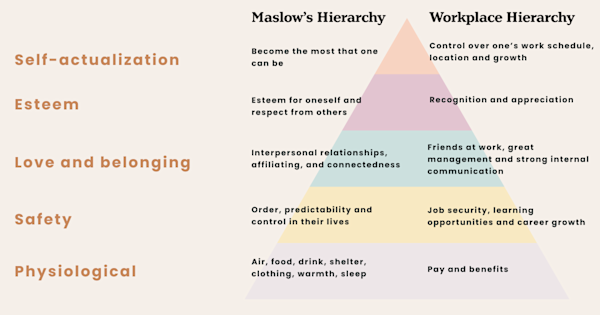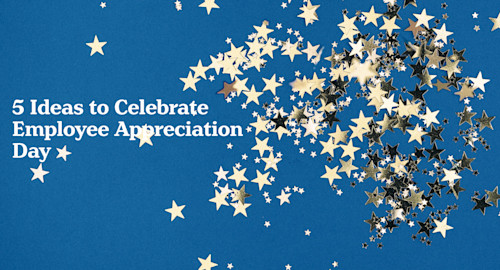Workplace Hierarchy of Needs: Why employee recognition programs fail
January 31, 2023

Every HR and culture project starts with the right intentions. But as we know all too well, the road to organizational hell is paved with good people and culture intentions.
Every HR and culture project starts with the right intentions. But as we know all too well, the road to organizational hell is paved with good people and culture intentions. Those good intentions in today's fast-scaling organizations are often designed to keep your team moving—people and culture programs, apps, and activities. It could be a new employee swag item that HR and Marketing think will be posted on social media. Or maybe it's an all-hands meeting at a resort for three days that you're sure will bring the team together.But these good intentions gone wrong can lead to employee dissatisfaction and resignations. Why? If your employees don't feel valued, giving them a pair of branded socks won't change that. Instead, it will drive your employees to look for an employer who truly values them for who they are as people in the office and at home.Since our start over five years ago, we've seen this happen over and over. Companies with the best intentions try to implement recognition programs, only to see them fail. We also see companies succeed with recognition by first addressing their employees' foundational needs.Helping you identify and address those needs is the reason for this guide. Over the following four chapters, we will go through four levels of needs that successful organizations deliver to their employees. Recognition programs work better than you imagine when you have a happy, fulfilled workforce.Culture might eat strategy for breakfast, but what is your strategy to build culture?
Why is recognition important?
It's no secret that people work better when they feel recognized and appreciated. There's data to back that up too. According to a report from Officevibe, 69% of employees said they would work harder if they felt their efforts were better recognized. Creating and sustaining a workplace recognition culture has numerous benefits, from increasing productivity to breaking down barriers and silos between employees and teams. The three most significant benefits we see from the businesses we work with are:
Retention
The turnover cost for an entry-level employee is between 30% and 50% of the annual salary. That doesn't include the damage to morale that can occur when influential employees in your organization leave for new opportunities. Employees are less likely to search for external opportunities when they feel engaged in their work and the team they're working with every day.
Engagement
Everyone benefits when employees are engaged at work. High engagement rates create more productive teams that work better across your organization. That increased engagement and productivity yields powerful results. In a 2021 poll, Gallup reported that companies with high employee engagement are 21% more profitable than those with lower engagement levels.
Employer Brand
Job boards are great—but nothing attracts better talent to an organization than positive word of mouth from your current employees. In a recent LinkedIn report, 75% of respondents said they researched an organization's reputation before applying for an open role. When your employees share their work experiences—and workplace recognition—on social media, potential candidates in their networks get to see your organizational culture in action.
Creating a solid foundation for recognition programs
The challenge for organizations is that recognition programs fall flat if your employees' basic needs aren't being met. You might see where this is going. The hierarchy of needs you know from psychology has analogs in the workplace.

The simple fact is that recognition programs will fail with employees whose basic physiological and safety needs aren't met.
It's just a place to work
Employees who view your organization as a place to collect a paycheck don't feel engaged with their work or team. One example is in the fast food industry, where pay is typically minimum wage and opportunities for advancement are hard to come by. With low pay and no real connection to work, the turnover rate might leave you breathless. "In the restaurant industry, turnover is 130%, turning over more than a full workforce every year," Panera Bread CFO Michael Bufano told the CNBC @Work Human Capital + Finance conference in July 2019. Turnover rates will vary by industry, but the reasons are the same:
Low pay: Employees working for minimum wage often have to work two or more jobs to pay for their basic living expenses.
Minimum vs. Living Wage: The living wage is what people need to earn to cover the actual costs of living in their community. In our hometown of Waterloo, Ontario, the current provincial minimum wage is $15.50, while the living wage is $17.20. Even with a living wage, employees may still balance paying bills with saving for their future.
No benefits: Even paying a living wage doesn't mean employees will have funds or days off for rest and relaxation—not to mention a holiday or other travel. This doesn't even consider the needs of someone falling ill without medical benefits or paid sick time.
For an employee whose basic needs aren't being met, giving them a gift card, branded swag, or other gifts can sometimes feel like an insult. An employee working more than one job would rather have an additional $25 on their paycheque than getting a pair of branded socks as a sign of appreciation.
How to level up
The benefits of providing employees with competitive pay and benefits are immediate. Employees are more engaged with their work and are less likely to leave for another opportunity. Less churn means reduced costs, fewer interruptions in productivity, and a more cohesive team.
Offer a competitive wage: A competitive salary provides employees with more than a paycheck. It gives them the mental safety net of having savings for future needs and emergencies.
Paid time off: Rest benefits more than just productivity. Having time to relax with family and friends benefits mental and physical health. Sick leave is also critical to employee and team health. If an employee has to come to work sick to avoid financial issues, the employer is not meeting their needs or obligations.
RESPECT: The most valuable asset an organization has is its employees. Treating them with respect, care, and compassion creates an environment where they feel supported and free to be their best selves in the workplace.
What is your workplace recognition strategy?
We're collecting insights from HR leaders to learn more about how you manage recognition and appreciation in the workplace, and we'd like to hear what you have to say.Our next post in this series will look at what organizations can do to improve their employees' feelings about safety and belonging in the workplace.
Get Started
Start building your recognition culture with us today.
Ready to make a difference in your employees’ lives and watch your company culture thrive? Contact us to speak with a member of our passionate team.

